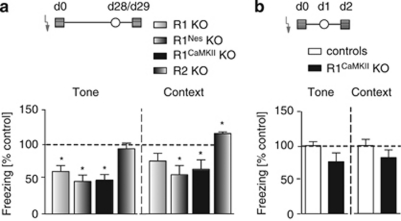Figure 1.
Limbic CRHR1 signaling promotes long-term consolidation of sensitized and contextual fear. (a) Conventional (R1 KO) and, in particular, conditional CRHR1 knockouts (Cre-induced brain-specific (Nestin promoter, R1Nes KO) and forebrain-specific (CaMKII promoter, R1CaMKII KO) CRHR1 deletions), but not conventional CRHR2 knockouts (R2 KO), show reduced freezing to a 3-min tone in a novel context (○) and to the shock context ( ) 28 and 29 days after exposure to an un-signaled electric foot shock (1.5 mA, 2 s;
) 28 and 29 days after exposure to an un-signaled electric foot shock (1.5 mA, 2 s;  ). Sample sizes were as follows: R1 (control/KO)=8/16, R1Nes=10/12, R1CaMKII=14/13, and R2=13/12. For the sake of clarity, freezing levels were expressed as a percentage of the means of the respective wild-type controls. (b) Genotype differences of R1CaMKII mice in freezing to tone and context were not significantly reduced, if animals were tested 1–2 days after foot shock. n (control/KO)=16/14. *p<0.05 (one-sample t-test).
). Sample sizes were as follows: R1 (control/KO)=8/16, R1Nes=10/12, R1CaMKII=14/13, and R2=13/12. For the sake of clarity, freezing levels were expressed as a percentage of the means of the respective wild-type controls. (b) Genotype differences of R1CaMKII mice in freezing to tone and context were not significantly reduced, if animals were tested 1–2 days after foot shock. n (control/KO)=16/14. *p<0.05 (one-sample t-test).

